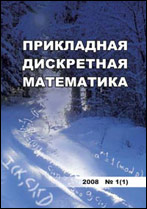|
Discrete Models for Real Processes
Concomitant clusters structure creating by Hammersley–Leath–Alexandrowichz algorithm for percolation cluster generating
D. V. Alekseev, G. A. Kazunina
Kuzbass State Technical University named after T. F. Gorbachev, Kemerovo, Russia
Abstract:
A three-dimensional cellular automaton implementing the simulation of growth of a percolation cluster on a simple cubic lattice according to the Hammersley–Leath–Alexandrowichz algorithm was built for the first time introducing into consideration the concomitant cluster structure formed out of cells excluded from the growth process. The concomitant cluster structure is modelled in a wide interval of perimeter germination probability values $0{,}3117<P<0{,}6883$ on a $100 \times 100 \times 100$ lattice and analyzed by using the functions of distribution of number and mass of clusters of the accompanying structure by size. As a result of the computational experiment, there were obtained dependencies on the probability of perimeter germination for such basic characteristics of the cluster structure as the mass of the main cluster; the mass of the maximum cluster of concomitant structure; the total mass of the concomitant structure; mean-square radii of the main cluster and the maximum cluster of the concomitant structure; the number of clusters of concomitant structure; mass ratio of the maximum cluster of the concomitant structure to the mass of the main cluster. It has been established that in the interval of germination probability $0{,}3117<P<0{,}62$ in the concomitant structure, the dominant cluster is formed with the mean-square radius close to the mean-square radius of the main cluster. With a further increase in probability of germination, the size of the dominant cluster decreases sharply, and at $P\leq 0{,}67$ its decay is observed.
Keywords:
cellular automaton, kinetic growth models, Hammersley–Leath–Alexandrowichz algorithm.
Citation:
D. V. Alekseev, G. A. Kazunina, “Concomitant clusters structure creating by Hammersley–Leath–Alexandrowichz algorithm for percolation cluster generating”, Prikl. Diskr. Mat., 2020, no. 47, 117–127
Linking options:
https://www.mathnet.ru/eng/pdm699 https://www.mathnet.ru/eng/pdm/y2020/i1/p117
|

|




 Contact us:
Contact us: Terms of Use
Terms of Use
 Registration to the website
Registration to the website Logotypes
Logotypes







 Citation in format
Citation in format 